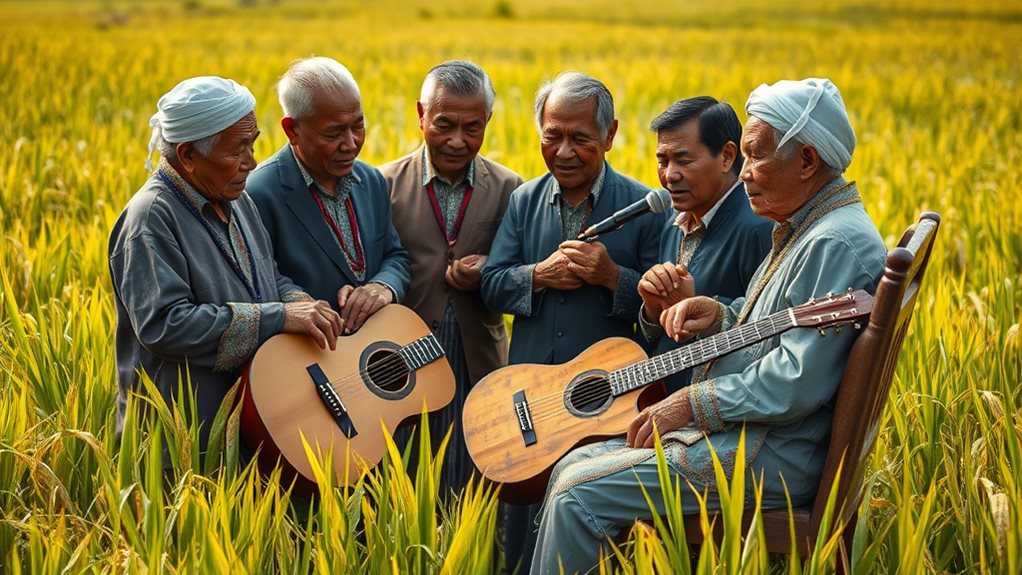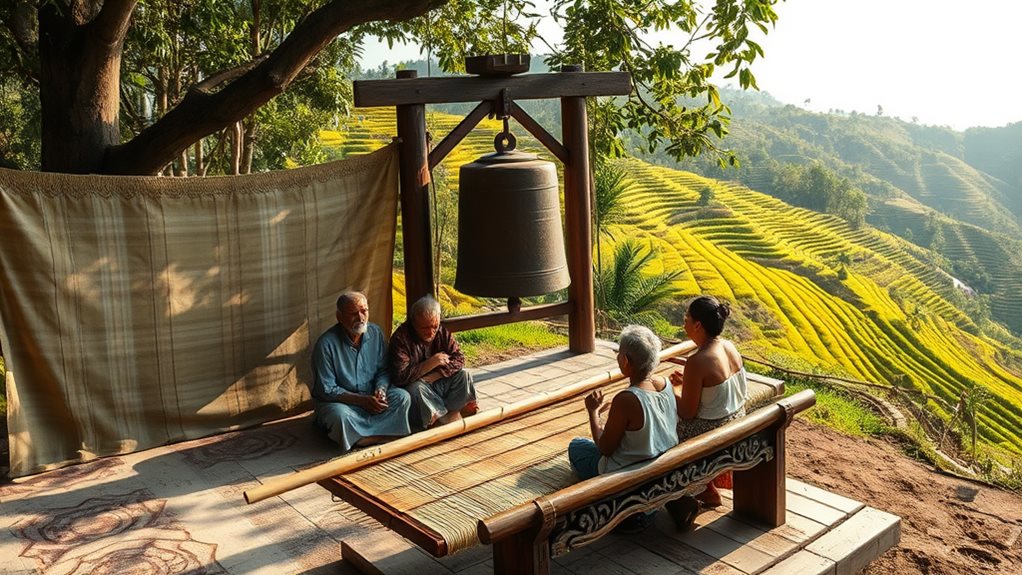Exploring the history and significance of Kapampangan folk songs reveals their integral role in shaping cultural identity. Learned in childhood, these songs function as storytelling mediums, preserving Aláya, the intangible life force essential to Kapampángan heritage. Symbolizing cultural ties and serving as sacred anthems for revolutionaries, they embody resilience and spirit during conflicts. Following the basultu form, a unique syllable pattern, folk songs adapt to seasonal events and festivals, celebrating cultural richness. Globalization poses threats, urging community initiatives like the Arti Sta. Rita Foundation to promote cultural revival. Contemporary artists reimagine traditions, integrating new genres and global music elements. Artists such as Lea Salonga and Apl.de.ap connect Kapampangan roots with international stages, enhancing cultural significance. By uncovering these layers, one gains insight into the deep cultural roots and evolving musical landscape of Kapampángan society.
Kapampangan Cultural Heritage

Singing Kapampangan folk songs, such as "Atin Ku Pûng Singsing," weaves integral threads into your cultural identity, learned from childhood and echoing the heritage of the Kapampángan people.
These folk songs serve not only as a medium for storytelling but also as a way to preserve history and reflect the values and beliefs of your community.
The tradition of seasonal music, featuring specific soundtracks for events like Halloween (gosu), Christmas (pastorela), and Lent (pasyun), underscores the rich musical diversity of Kapampangan heritage.
The premiere of "Ing Managpe," the first Philippine zarzuela in vernacular, highlights your significant contribution to broader Filipino theatrical traditions.
Festivals and community celebrations, such as the serenata, further emphasize the role of music in fostering cultural identity and collective memory among the Kapampángan people.
Through these cultural expressions, your musical heritage not only entertains but also educates, strengthening your cultural identity.
Historical Context and Symbolism
Your culture's folk song "Atin Ku Pûng Singsing" encapsulates layers of historical significance and symbolic meaning, serving as a tangible link to Kapampángan heritage. This folk song symbolizes a lost inherited ring, representing deeper cultural ties and identity. Historically, "Atin Ku Pûng Singsing" functioned as a sacred anthem among Kapampángan revolutionaries, embodying resistance against colonial threats and preserving cultural heritage. Its structure follows the basultu form, a pattern distinct to traditional Kapampángan music. During conflicts, folk songs like "Atin Ku Pûng Singsing" were utilized as both communication tools and morale boosters among the people.
| Aspect | Explanation |
|---|---|
| Symbolism | Represents a lost ring, symbolizing deeper cultural meanings and identity |
| Historical Context | Functioned as a sacred anthem in resistance against colonial threats |
| Basultu Form | Follows a specific syllable pattern, exemplifying traditional music |
| Communication Tool | Used during conflicts to convey warnings and boost spirits |
This folk song not only celebrates the cultural richness of Kapampángan people but also embodies their resilience and spirit through hidden symbolic layers intertwined with historical events.
Concept of Aláya

The concept of Aláya encapsulates the intangible life force and spirit that's fundamental to the completeness of Kapampángan identity and culture, underscoring the intrinsic connection between spirituality and cultural heritage in every facet of life.
This concept, integral to cultural preservation, is vividly represented in the folk song "Atin Ku Pûng Singsing," where the lost ring symbolizes Aláya, highlighting the significance of heritage and cultural roots in Kapampángan society.
Facing colonial threats meant to erase cultural uniqueness, the concept of Aláya became a rallying point, emphasizing the importance of maintaining Kapampángan identity.
Music, particularly folk songs, became vital vessels for preserving and passing down Aláya, enabling the community to connect with their cultural heritage across generations.
Emphasizing Aláya underscores the urgent need for cultural preservation efforts among younger generations to ensure the continuation of Kapampángan traditions and identity.
Cultural Preservation Challenges
In facing today's cultural preservation challenges, Kapampángan language and identity increasingly find themselves at odds with the advancing tide of globalization and assimilation, leaving younger generations to grapple with the struggle of learning and using their native dialect amidst a growing preference for dominant languages and cultural practices. The urgency to protect and preserve cultural practices becomes paramount as the extinction of native music threatens Kapampángan heritage. Losing traditional folk songs and customs can lead to a disconnection from cultural roots, underscoring the importance of recognizing and rediscovering these elements. Community initiatives, such as those by Arti Sta. Rita Foundation Inc., work to enhance cultural awareness among the youth, involving them in preserving Kapampángan traditions.
| Initiatives | Goal | Methodology |
|---|---|---|
| Arti Sta. Rita Foundation Inc. | Cultural awareness | Workshops, performances, educational programs |
| Language revitalization programs | Nativization | Language classes, cultural expos, public speaking |
| Folklore documentation | Patrimony preservation | Oral histories, archiving, research |
| Social media campaigns | Promotion | Sharing, advocacy, engagement |
| Government policies | Structural support | Funding, legal framework, cultural policies |
The ongoing evolution of cultural identity necessitates a commitment from both local communities and government entities to sustain and promote Kapampángan music and practices. These efforts are critical for the cultural preservation of Kapampángan heritage.
Call to Future Generations

Active engagement with Kapampángan language and identity, sparked by community initiatives and government policies, now calls upon future generations to maintain their cultural heritage.
Learning and speaking the Kapampángan language are crucial for preserving your cultural identity and heritage. Embracing Kapampángan culture through participation in traditional practices and music, especially folk songs, ensures these traditions remain vibrant.
The ongoing evolution of cultural identity is pivotal for fostering pride and connection to your roots. Initiatives like Aldo ning Kapampángan, which celebrates cultural festivals and community involvement, underscore the importance of these efforts.
It becomes your responsibility to pass down this knowledge, ensuring Kapampángan folk songs continue as a living part of your culture. This active continuation will secure the cultural wealth for future generations.
Political and Social Influence
Exploring backwards reveals how Kapampangan music has woven into the fabric of political and social change, playing a crucial role in mobilizing collective action and identity.
In the 1920s-1930s, Kapampangan music introduced socialist ideas to local peasants through the "Pasyon ding Talapagobra," reimagining Christ as a socialist figure to resonate with the economic struggles of the community.
During World War II, resistance fighters used Kapampangan music to boost morale, performing songs during marches and battles to unify and inspire comrades amidst conflict.
Survivors of wartime atrocities in Candaba utilized music as a coping mechanism, expressing their experiences and communicating their traumas through song.
The emergence of "Apat-Apulung Aldo" after the 1972 flood in Pampanga demonstrated how Kapampangan music reflects resilience and solidarity in the face of hardship.
Throughout these periods, Kapampangan music has historically served as a means of resistance and communication, conveying messages of hope, identity, and social change essential for navigating and transforming difficult times.
Modern Musical Evolution

Kapampangan culture's possessive tradition of theatrical performances continues to evolve, as evidenced by the staging of the original zarzuela "Ciniong" to celebrate the 75th birthday of a beloved archbishop. This modern musical evolution not only maintains cultural significance but also integrates American elements into age-old forms, reflecting global influences on regional art.
Contemporary artists actively revive musical genres like Ara Muna and RocKapampangan, updating traditional polosas and kantang ukbu to resonate with today's audiences. Through these adaptations, folk song traditions aren't discarded but rather reimagined, allowing new generations to connect with old melodies and themes.
Mon David and O.K. Musica exemplify this trend by introducing jazz influences into love songs, demonstrating Kapampangan music's adaptability and its ability to incorporate diverse sounds while preserving its core essence. Additionally, Kapampangan hymns cover all liturgical seasons, showcasing a diverse musical repertoire that evolves through the lens of liturgical practice.
This multifaceted evolution illustrates the dynamic relationship between traditional music and contemporary artistic expression in Kapampangan culture.
Notable Kapampangan Artists
Among the diverse forms of cultural expression that highlight the adaptability and richness of Kapampangan music, the contributions of notable artists stand out as significant markers of artistic achievement and cultural pride.
Fides Cuyugan Asencio, for instance, as an opera diva, has made considerable contributions to classical music and performance arts, exemplifying the cultural significance of Kapampangan talent.
International recognition also graces Cecile Licad, a pianist renowned for her performances in prestigious venues globally, reinforcing Kapampangan musical prowess.
Lea Salonga, a Broadway star famous for her roles in "Miss Saigon" and "Les Misérables," embodies the region's artistic talent on global stages, significantly enhancing Kapampangan cultural significance.
Furthermore, apl.de.ap, a member of the Grammy Award-winning group Black Eyed Peas, incorporates his Kapampangan roots into his music and advocacy, illustrating the broad reach of Kapampangan influence in contemporary music.
Mon David, a jazz musician celebrated for his unique vocal style, further impacts the modern music scene by highlighting Kapampangan culture, enriching Kapampángan Studies.
Each of these individuals exemplifies the depth and breadth of Kapampangan artistic expression.
Questions and Answers
What Folk Song Originated in Pampanga?
Atin Ku Pûng Singsing originated in Pampanga, embodying Kapampangan traditions, themes of cultural preservation, and used at community gatherings, often with musical instruments, reflecting deep heritage.
What Is the Significance of Folk Songs?
Significance of folk songs includes preserving cultural identity through oral tradition, fostering community bonding, maintaining historical preservation, and facilitating artistic expression across generations.
What Is the Story Behind Atin Cu Pung Singsing?
Atin Cu Pung Singsing explores cultural identity through musical heritage, using storytelling techniques and regional variations tied to traditional instruments to preserve Kapampangan spirit and heritage.
What Is the Most Famous Kapampangan Folk Song Used in the Sinukwan Festival?
Atin Ku Pûng Singsing, representing Kapampangan cultural heritage, evolves through Sinukwan festival traditions, using local musical instruments and community storytelling methods to reflect unity and history.